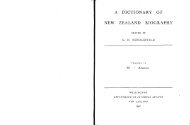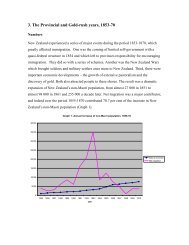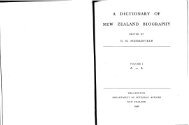Wellington cafe culture 1920-2000 - NZHistory.net.nz
Wellington cafe culture 1920-2000 - NZHistory.net.nz
Wellington cafe culture 1920-2000 - NZHistory.net.nz
You also want an ePaper? Increase the reach of your titles
YUMPU automatically turns print PDFs into web optimized ePapers that Google loves.
Zealand included) the resurgence was particularly noticeable. Reasons include the increase in international<br />
travel, the breaking down of communication and trade barriers, and the impact of global fashions.<br />
European immigrants<br />
In New Zealand, national trends and events also contributed to the rise, decline, and eventual return of<br />
the coffee bar. Perhaps the most important was immigration before and after the Second World War. From<br />
1936 a small number of European refugees began arriving in New Zealand. They were dismayed at the<br />
absence of cafés, and when establishments such as <strong>Wellington</strong>'s French Maid opened in the 1940s,<br />
refugees tended to gather there. In other places, refugees set up their own cafés: for example in Hamilton<br />
in the late 1930s Kurt Phillips, a German Jew from Cologne, started the Vienna coffee house.<br />
The American influence<br />
Another early influence was the stationing of American troops in Auckland and <strong>Wellington</strong> from 1942.<br />
While special service clubs catered for these soldiers' cravings for familiar foods, local outlets also<br />
emerged to serve the need. In <strong>Wellington</strong>, coffee shops and milk bars are said to have sprung up along<br />
Willis Street and Lambton Quay, while in Auckland places such as Somervells Milk and Coffee Bar were<br />
established in response to the American demand.<br />
Changes in New Zealand society<br />
The novelty of these new cafés was more generally appealing. It has been suggested that New Zealanders<br />
were by this time more open to trying other types of food and drink, partly because of the rise of a localborn<br />
population and the weakening of links with the British food tradition. Moreover New Zealand writers,<br />
musicians, artists and scholars - as well as the educated middle classes - welcomed European immigrants<br />
and the <strong>culture</strong> they brought with them. The pervasiveness of American films and fashions may also have<br />
encouraged young people to adopt American customs.<br />
Post-war immigration and travel<br />
Post-war immigration brought more European migrants to New Zealand, keen to recreate the ambience of<br />
the café in their new land. Assisted immigration from the Netherlands ensured that the Dutch were<br />
influential from the 1950s. However, it appears that they were just participating in a national movement,<br />
influenced by the overseas boom in coffee houses. Auckland, like <strong>Wellington</strong>, experienced a sudden<br />
upsurge in cafés in the late 1950s and they appeared even in smaller towns. Increased travel among<br />
younger people, particularly young women, seems to have been significant.<br />
New Zealand's liquor laws<br />
New Zealand's antiquated liquor laws, which prohibited the sale of alcohol in restaurants and limited hotel<br />
hours to 9 am to 6 pm, contributed to the popularity of coffee houses in the 1950s. Many cafés stayed<br />
open until late - often the early hours of the morning. They filled a growing need for night-time<br />
entertainment. Women, effectively excluded from drinking alcohol in public except in the lounge bars of<br />
hotels until the 1970s, may well have found coffee bars a more congenial place to socialise. They often<br />
served good food, as the forerunners of licensed restaurants, and sometimes openly challenged the liquor<br />
laws by allowing patrons to smuggle in bottles of wine. Futile police raids gained them favourable publicity<br />
and in 1960 licensing laws were changed to allow restaurants to serve wine with food. However, the 'six<br />
o'clock swill' remained in force until 1967, ensuring that cafés continued to perform a vital social role as<br />
places of evening entertainment.<br />
The decline of coffee houses<br />
The decline of coffee houses in the late sixties can also be attributed to national events. The change in the<br />
liquor laws in 1967 to allow hotels to remain open until 10 pm provided the public with another form of<br />
nightlife. The growing importance of processed foods, including instant coffee, in the diet of New<br />
Zealanders from the mid 1960s, could have been another factor. It has also been suggested that as a<br />
result of import restrictions after the 'black budget' of 1958, it was no longer possible to import espresso<br />
machines or spare parts for them. Finally, the rise of television may have made home entertainment more<br />
attractive.








